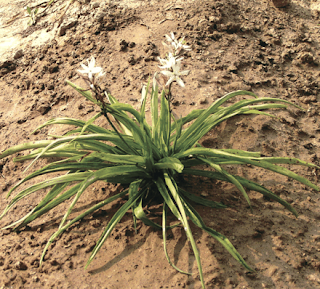Wednesday, June 16, 2010
Safed Musli History
India is bestowed with a wealth of herbal cure plants, most of which have been used in Ayurveda, Unani systems of medicines, and by tribal healers. Safed musli (Chlorophytum borivilianum L., Liliaceae) holds an important position in Indian herbal medicine. The roots are widely used as a natural "sex tonic" and is an integral part of more than 100 herbal cure formulations . Although Indian forests are rich in safed musli demand is increasing rapidly in Indian and international drug markets. Foreign demand has been estimated as 300-700 tonnes annually , a quantity that Indian forests cannot sustain. This has created a pressure on Indian forests and if steps for timely conservation are not taken, the Indian forests will lose this valuable plant . At present the availability of musli is decreasing and obnoxious weeds like Parthenium hysterophons and Lantana are taking its place.
Dried roots of Chlorophytum contain 42% carbohydrate, 80–9% protein, 3–4% fiber and 2–17% saponin . Research studies on Chlorophytum conducted in India and elsewhere indicate that saponins are responsible for medicinal properties. Saponins are thought to be highest in roots of forest origin.
More than 175 species of Chlorophytum have been reported in the world. Chloophytum comosum is widely used as ornamental plant where it is commonly known as spider ivy, spider plant, aeroplane plant, or walking anthericum. Thirteen species of Chlorophytum have been been reported in India. All these species differ in appearance, native species are sold as sufed musli in the Indian drug market. Chlorophytum boriviliahum produces the highest yield and highest saponin content. Other native Indian Chlorophytum species include C. arundinaceum, C. tuberosu, C. laxum, and C. breviscapum.
Different species of Chlorophytum available in India.
Chlorophytum arundinaceum
All districts of Chota Nagpur, Vindhya, Satpura and Aravali Hills, parts of Central India. Taria region of N-E Himalayas in Assam. West Bengal and Bihar.
Chlorophytum attenuatum
Western Ghats, southwards to Comibatore, West Peninsula.
Chlorophytum borivilianum
Dangs Forests (Gujarat). Aravali Hills
Chlorophytum laxum
Katki Hills, Belgaum, Dharwar, North and South Kanara, Deccan peninsula in India.
Chlorophytum tuberosum
Parts of Konkan to Travancore in Kerala, Eastern Himalaya, Bihar and West Bengal.
Chlorophytum hreviscapum
Sikkim Himalaya, Belgaum and South Peninsula.
In nature, musli propagates vegetatively through its fleshy roots., rarely by seed. The black angular seed is similar to onion seed in appearance. Seed have poor germination and low viability. Seed rates of 3 quintals/hectare is considered optimum for growers.
Chlorophytum is found in soils rich in organic matter. It requires bright sunlight for good growth . Many tribal communities of India use the fresh leaves of Safed musli as potherb,but the roots are the useful part of the plant for medicinal purposes. Once the root is harvested reseeding rarely occurs.
Innovative Indian farmers have initiated commercial cultivation of safed musli. The crop is a popular rainy season (kharif crop) in India and a commercial root harvest can be obtained in 3–4 months. Spacing 30 × 15 cm is optimum. The crop seems adapted to a wide range of conditions. Few insect pests have been reported. Saponin content may be affected by fungicides and synthetic pyrethroides. Many moosli farms have started selection of cultivars.
There is now a heavy demand of organically grown safed musli with high saponin content in national and international drug market. In India musli-based products are coming regularly to the market. The area under this crop is increasing rapidly in India.
Medicinal Benefits of Safed musli
Safed Musli is popularly known as Indian herbal Viagra. Ayurvedic texts eulogize the myriad medicinal properties of this herb. Ayurveda acharyas have successfully used this herb in conditions like diabetes, erectile dysfunction, premature ejaculation, low sperm count and low sperm motility. Its anti inflammatory properties help in arthritis. Tubers of this plants increase milk production in lactating mothers. Body builders are also benefited by this herb as it increases healthy muscle mass.
Health Benefits of Safed Musli
According to principles of ayurveda safed musli is heavy, unctuous, sweet to taste and has cooling property. Its action on tridoshas is based on these properties. It alleviates vata by virtue of its qualities like heaviness and unctuousness. Musli normalizes pitta due to its properties like heaviness, cold and sweet taste. Hence it is very useful in diseases which involve aggravation of vata and pitta.
Shukra dhatu or semen is made up of Jala (water) and prithvi (earth) mahabhutas . Unctuous, heaviness and cold properties of safed musli increase jaladhatu and prithvidhatu. These properties in turn increase volume of semen, sperm count and sperm motility. Principles of ayurveda mention that increase in quality of shukra dhatu helps to increase potency of men. Regular consumption of this herb helps in erectile dysfunction, premature ejaculation and revitalization of male reproductive system.
Musli helps to increase muscle bulk and is a boon to body builders. It facilitates a quick recovery in recuperating persons. Lactating mothers are more benefited by this. Safed musli helps in rejuvenation of liver in jaundice patients. Researches have shown the anti-inflammatory and anti diabetic properties of this herb .Hence it is used in arthritis and diabetes.
As Musli grows naturally in most parts of Central region of India, the normal climate of the central region suits the crop most and as per practical experience it can also grow successfully in the wide range of temperature and rainfall. Sandy loam soil with proper drainage system facilitates its growth. We can divide the cultivation in four major parts namely:
* Land Preparation
* Plantation
* Maintenance
* Harvesting
Land Preparation
Land preparation takes almost 2-3 months:
* Deep Ploughing, Tillering is must to give land a better Pulverization and Dryness in the month of March and April.
* At least twenty trolleys of Cow dung manure should be mixed in the month of April or May.
* Raised beds should be prepared (as per planning of plantation) in the end of Month May.
* All the raised Beds should be well irrigated before sowing the planting Material.
Plantation of Safed Musli Plantation
The complete yield depends upon the plantation of crop. Planting Material required per acre is 500kg.
* This material is then operated in pieces of 15 to 20 gms.
* These cutted piece are of two to three fingers approximately attached to a part of crown.
* This is the actual planting material which is then treated with growth hormones for better germination & contact fungicide to protect it from any kind of fungus.
* Then each single piece is sowed at a distance of 10 inches X 12 inches on the raised bed.
Maintenance of Safed Musli
* Weeds should be controlled either by weeding by labour or at the time of land preparation.
* Any kind of deficiency should be immediately traced and the required element should be supplied.
* The first three months from the sowing date are very important and the field needs most care.
* The complete maintenance of Safed Musli cultivation per acre amounts to 1 lakh approx.
Harvesting
Harvesting is nothing but combination of three process namely
-Digging: This means digging the bunch of safed musli from ground. This process involves around 60-70 men's per day to dig one acre land. The complete process should be seen by the labour so as to enable him to get the complete yield safely.
-Drying: Part of the yield dogged out is peeled and then dried to almost 20%. This dried musli is then sent to the market. There should be a clear understanding of this process.
-Re plantation: As the experience regarding the crop cultivation is gained therefore the planting material obtained from the digging process should be sown in the ready fields within two days.
Yield and Price
About ten quintals of fleshy root (wet) per hectare, is collected. This, after processing and drying is reduced to 200 kg (about 20% of wet root wt). In the domestic market, the rates ranges between Rs 800 to Rs 1800 per kg depending on the quality of the product.
Uses & Benefits of Safed Musli
* Safed musli is a very popular aphrodisiac agent, with no side effects. It is often prescribed for enhancing male potency and overcoming signs of fatigue. It is particularly used for individuals with low sperm count and low libido.
* It is also regarded as an energy booster in asthmatic conditions. The roots of the herb are also used to strengthen the general immune system of the body.
* The tuber roots of the plant have been used since ancient times, to prepare nutritive tonic for sexual weakness and is used in Ayurvedic medicines even today.
* Safed musli proves useful as a nutritive tonic for both the mother and the fetus, during pregnancy and is also used to replenish the body fluids during the post-partum stage.
* The herb improves the quantity and flow of breast milk, in feeding mothers.
* It has many health promotional benefits. It is used to control and prevent obesity and its side effects.
* The activities of vitamin C and antioxidant enzymes are also enhanced by the use of this plant species.
* Research has indicated that the plant species is used for curing diabetes and arthritic conditions.
* Safed musli is also beneficial in the treatment of natal and postnatal problems.
* Its regular use causes increase in the level of High Density Lipoprotein (HDL or good cholesterol) and decrease in the plasma and hepatic lipid profiles.
* Apart from rejuvenating the reproductive system, the herb prevents premature ejaculation and is also used in chronic leucorrhoea.
Compiled by Harsh Saxena
Labels:
herbal cure,
herbs,
medicinal herb,
medicinal seeds,
musli,
safed musli,
seitenbacher
Subscribe to:
Post Comments (Atom)






No comments:
Post a Comment